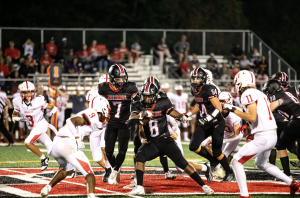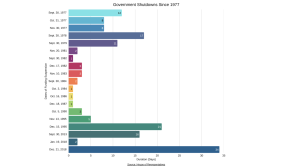Is there hope for rock music?
May 3, 2019
Sure, it might be trite to say, but rock is dead.
The groups that sell out the biggest stadiums are decades past their prime. Cheap commercial pop masquerading as rock rules the airwaves, performing songs that you’re more likely to recognize from Toyota commercials than your Spotify playlists. And the lead singer of the band breaking records on the Billboard Hot Rock Songs died 28 years ago.
But before I start to sound like someone’s dad, let me backtrack a bit.

I think the death of rock music is a good thing. Decades before Halsey and Katy Perry first autotuned over synthesizers on 99.5, glam-rockers like Poison and Cream reached the same heights of vapidity and appropriation. And I am certainly not advocating for replacing Migos with my dentist’s “classic” rock collection.
But more importantly, the death of mainstream rock carved out a niche for an indie-rock resurgence, a sprawling scene unencumbered by the trappings of its parent genre. While often dismissed as pretentious and inconsequential, indie-rock is the true inheritor of the innovative spirit that musical pioneers like the Beatles and Pink Floyd once epitomized. This goes back to the genre’s 20th-century roots.
In the early 80s, the first “indie pop” and “alternative rock” bands emerged in the UK, rejecting mainstream rock’s embrace of synthesizers and visual glamour. Similarly, cult bands like Sonic Youth and the Pixies in the United States sought to reclaim the genre as an experimental, groundbreaking art form, as opposed to a made-for-TV cash cow.
Eventually, the term “indie-rock” was coined as a nebulous catch-all for artists working outside the corporate money-making machine. Many outfits were showered with critical praise, but commercial success remained elusive without the promotional clout of the major labels.
This remained the case until the 90s when Oasis and Nirvana exploded into the spotlight in Britain and America respectively. Their brief reign on the charts marked a golden age for indie-rock, paving the way for experimental and alternative bands like the Red Hot Chili Peppers, Weezer, and the Smashing Pumpkins to acquire major label contracts and massive fan bases. Indie rock even became interchangeable with “rock,” as glam-metal bands like Poison and Bon Jovi fell out of fashion.

Eventually, indie-rock even developed its own trademark sound: distorted guitars, chiming riffs, and an emphasis on emotionally charged lyrics over vocal technique.
But with Brit-pop’s collapse and Kurt Cobain’s death, rock lost it’s core identity and once again faded into obscurity. The remnants of the genre generally fell into two categories: cheap imitators and generic guitar bands. While the New York scene survived this blow, thanks in large part to the output of the Strokes and the National, so-called “landfill indie” was no match for the rise of EDM, R&B, and rap in the 2000s.
With the labels gone, most indie groups have once again been relegated to tiny gigs in cheap bars and old state theaters, occasionally lucking into a hit single, before just as quickly being dismissed as a one-hit wonder by the mainstream.
However, thanks to the popularization of streaming apps, and music sharing platforms, there may still be hope for the genre.

In recent years, indie outfits Tame Impala and the Arctic Monkeys shot to fame after posting tracks on My Space, Oh Wonder on Soundcloud, and Glass Animals on Spotify. Combining the classic rock instrumentation (bass, drums, lead and rhythm guitar) with an ever-growing electronic arsenal, this third wave is breathing new life into the genre.
While rock music may be dead, it’s rebellious offspring are once again starting to sell out stadiums. And with pretenders like Maroon 5 and Imagine Dragons ruling the rock charts, now they have something to prove.
Here are five acts that do so:
1. Peach Pit

Hailing from Vancouver, British Columbia, Peach Pit is the latest entry in the thriving West Coast indie scene. Self-described as “chewed bubblegum pop” the group has built a significant following through their energetic live shows and internet output. While the band’s laid back vocals and behind-the-beat rhythms call to mind Wavves and Wallows, guitarist Chris Vanderkooy’s jangly riffs and technically complex licks provide the band with significantly more verve.
2. Blanco White

After studying classical guitar in Spain and the charango in Peru, Londoner Josh Edwards created Blanco White to “bring together elements of Andalusian and Latin American music.” In the process, he has created a thoroughly original sonic landscape of spine-tingling indie-folk songs, complete with flamenco riffs, choral accompaniments, and top-notch production. Edwards’s voice, alternating between thunderous and fragile, provides emotional energy to his highly technical guitar playing.
3. Rex Orange County

Rex Orange County is the kind of Indie rocker that gives hope to aspirant Soundcloud-musicians around the country. With an underwhelming voice and laid-back instrumentation, ROC’s lovesick ballads are glued together with fantastic hooks and quick tempos, which makes them both accessible and energizing. Additionally, ROC’s music is choked with nostalgia, aided in part by the condensed, fuzzy production that evokes the sound of the Beach Boys and their progenitors.
4. The Antlers

Despite its expansive, ambitious sound, the Antlers began as the solo project of frontman, Peter Silberman, during a period of “social isolation.” Silberman wrote the entirety of “Hospice” alone in his bedroom, and his contemplative lyrics coupled with ethereal electronic instrumentation combine to create a deeply affecting meditation on loneliness and loss. Now supported by several hired-guns, the Antlers’ sound has expanded beyond introspective shoe-gaze, incorporating more instruments, optimism, and experimentation.
5. Middle Kids

It takes a lot for an obscure band to receive a glowing endorsement from Sir Elton John, but that is exactly what happened to this trio of classical musicians-turned anthemic indie rockers. Middle Kids’ songs are often about unrequited love and failed relationships, but can’t seem to help but overflow with energy and optimism, partly the result of Hannah Joy’s powerful, exuberant vocals. This pairs wonderfully with Tim Fitz’s distorted guitar, which evokes a curious mixture of warmth and emptiness; think driving with your best friends down a shimmering desert highway.








